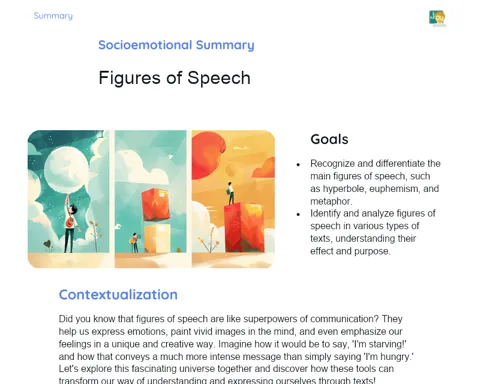Object Pronoun | Active Summary
Objectives
1. 🎯 Identify and correctly use direct and indirect object pronouns in Spanish.
2. 🎯 Recognize and apply the different positions that object pronouns can occupy in a sentence, depending on verb conjugation and context.
3. 🎯 Develop the linguistic analysis skill to differentiate between direct and indirect object.
Contextualization
Did you know that using object pronouns in Spanish can completely transform the fluency and efficiency of communication? In Spain, for example, it is common to hear the extremely fluid and fast use of direct and indirect object pronouns, which makes conversations more dynamic and rich. Mastering these pronouns is not only essential for grammar but also for expressing oneself naturally and clearly, bringing one closer to the level of a native speaker. 🚀
Important Topics
Direct Object Pronoun (CD)
The direct object pronoun (CD) in Spanish replaces a direct object, meaning the entity that directly receives the action of the verb, without the need to be preceded by a preposition. For example, in 'Ella come la manzana' (She eats the apple), 'la' is the CD pronoun that replaces 'la manzana.'
-
Direct substitution: The CD pronoun replaces the direct object, avoiding unnecessary repetitions and making communication more efficient.
-
Position in the sentence: In Spanish, the CD pronoun usually comes before the conjugated verb. For example, 'Lo veo' (I see him), where 'lo' comes before 'veo.'
-
Agreement: The CD pronoun must agree in gender and number with the direct object it replaces.
Indirect Object Pronoun (CI)
The indirect object pronoun (CI) in Spanish is used to replace the indirect object, which is affected by the action of the verb but does not directly receive that action. Unlike the CD, the CI is always preceded by a preposition. For example, in 'Ella le escribe una carta a su amigo' (She writes a letter to her friend), 'le' is the CI pronoun.
-
Prepositions: CI pronouns are usually accompanied by prepositions that indicate to whom or for whom the action is directed.
-
Variation of prepositions: Depending on the verb and context, the preposition accompanying the CI pronoun may vary, requiring special attention in practice.
-
Position in the sentence: In structures where the CI and CD pronouns appear together, the CI precedes the CD.
Positions of Object Pronouns
Object pronouns in Spanish can occupy different positions in the sentence depending on verb conjugation. Moreover, these positions may vary to emphasize or soften certain elements of communication. Understanding these variations is crucial for effective communication.
-
Enclitics and proclitics: Enclitic pronouns are those that are attached to the verb, usually at the end of the conjugated form, while proclitic pronouns come before the verb.
-
Enclitic and proclitic: The choice between enclitic and proclitic may depend on the type of verb, the formality of the speech, and the emphasis intended on the pronoun.
-
Impact on communication: The position of object pronouns can significantly alter the meaning of a sentence, highlighting different elements or nuances of the action.
Key Terms
-
Direct Object Pronoun (CD): Replaces the direct object of the sentence without the need for a preposition.
-
Indirect Object Pronoun (CI): Replaces the indirect object, always accompanied by a preposition indicating to whom or for whom the action is directed.
-
Enclitic: Placement of a clitic pronoun after the verb.
-
Proclitic: Placement of a clitic pronoun before the verb.
To Reflect
-
How can the position of object pronouns change the meaning or emphasis of a sentence? Provide examples.
-
Why is it important to differentiate between direct and indirect objects when using object pronouns?
-
In what way does the study and practice of object pronouns contribute to fluency and naturalness in Spanish communication?
Important Conclusions
-
We reviewed the importance and use of direct and indirect object pronouns in Spanish, essential for fluent and effective communication.
-
We understood how these pronouns replace direct and indirect objects in sentences, saving words and making speech more dynamic.
-
We explored the variation in the position of pronouns, such as enclitics and proclitics, and how this affects the meaning and emphasis of sentences.
To Exercise Knowledge
Create a journal for a week. Note at least five daily situations where you could use object pronouns. Write the complete sentence and then rewrite it by replacing the direct and indirect objects with the corresponding pronouns. Reflect on how this affected the clarity and fluency of your sentences.
Challenge
Master Pronoun Challenge: With a friend or family member, practice a dialogue where you can only use object pronouns. Try to keep the conversation fluid and understandable. Record and watch to see how clarity in communication can be maintained without repeating objects.
Study Tips
-
Use flashcards to practice memorizing the pronouns and their positions in different types of sentences.
-
Watch films or series in Spanish and try to identify the use of object pronouns. This can help understand their use in context better.
-
Practice writing small stories or dialogues, focusing on the correct and varied use of object pronouns to improve your written expression skills.



